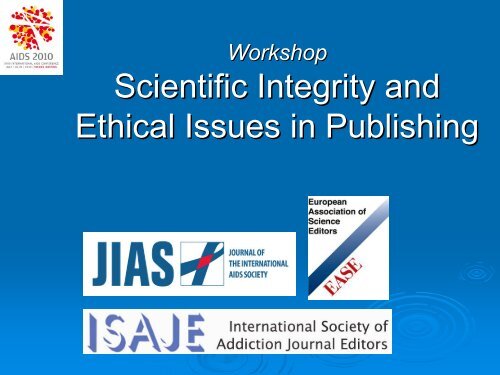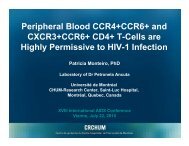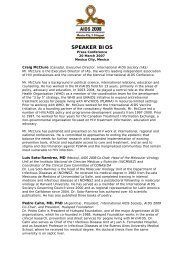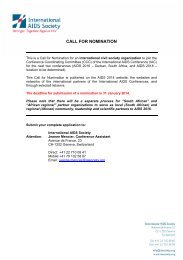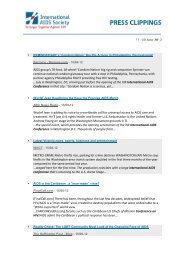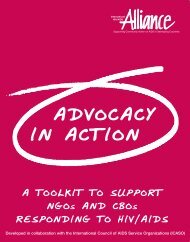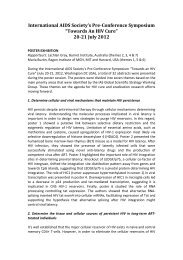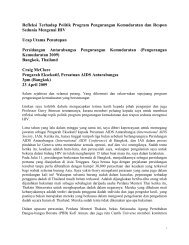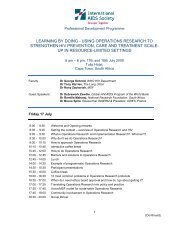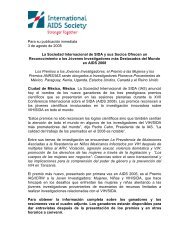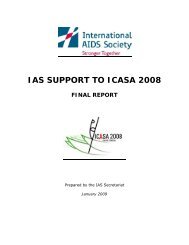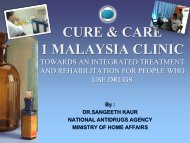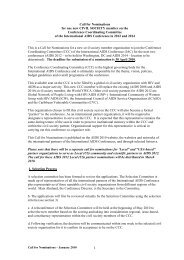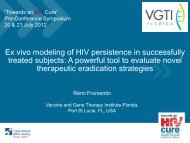Scientific Integrity and Ethical Issues in Publishing - International ...
Scientific Integrity and Ethical Issues in Publishing - International ...
Scientific Integrity and Ethical Issues in Publishing - International ...
You also want an ePaper? Increase the reach of your titles
YUMPU automatically turns print PDFs into web optimized ePapers that Google loves.
Workshop<br />
<strong>Scientific</strong> <strong>Integrity</strong> <strong>and</strong><br />
<strong>Ethical</strong> <strong>Issues</strong> <strong>in</strong> Publish<strong>in</strong>g
Publication Ethics<br />
The deliberate <strong>and</strong> systematic consideration<br />
or moral problems aris<strong>in</strong>g <strong>in</strong> connection<br />
with the publication of scientific research.
Procedures to prevent or resolve<br />
moral dilemmas<br />
• <strong>Ethical</strong> review<br />
• Risk-benefit analysis<br />
• Informed consent<br />
• Peer review<br />
• Uniform requirements for attribut<strong>in</strong>g<br />
authorship credits<br />
• Professional ethics: <strong>Ethical</strong> Guidel<strong>in</strong>es
Author Declarations<br />
Journal <strong>Ethical</strong> Policies<br />
‣ Authorship Statement – Declaration of substantive<br />
contribution signed by all authors<br />
‣ Conflict of Interest Statement – Declaration of real <strong>and</strong><br />
apparent Conflicts of Interest, <strong>in</strong> language<br />
comprehensible to average reader, signed by all authors<br />
‣ Redundant Publication Statement – Declaration that the<br />
work has not been published previously <strong>in</strong> whole or <strong>in</strong><br />
part<br />
‣ Human/animal subjects Statement – Declaration that the<br />
study was reviewed by an <strong>Ethical</strong> Review Committee<br />
‣ Duplicate submissions - Declaration that the work has<br />
not been published, or is not be<strong>in</strong>g considered for<br />
publication, by another journal
<strong>Integrity</strong> <strong>in</strong> Research Publish<strong>in</strong>g<br />
‣ Intellectual honesty <strong>in</strong> report<strong>in</strong>g research<br />
‣ Accuracy <strong>in</strong> represent<strong>in</strong>g contributions of other<br />
scientists<br />
‣ Collegiality <strong>in</strong> scientific <strong>in</strong>teractions, <strong>in</strong>clud<strong>in</strong>g<br />
communications <strong>and</strong> shar<strong>in</strong>g of <strong>in</strong>formation<br />
‣ Transparency <strong>in</strong> conflicts of <strong>in</strong>terest or potential<br />
conflicts of <strong>in</strong>terest<br />
‣ Protection of human subjects <strong>in</strong> the conduct of<br />
research<br />
‣ Humane care of animals <strong>in</strong> the conduct of research<br />
‣ Adherence to the mutual authorship responsibilities<br />
between <strong>in</strong>vestigators <strong>and</strong> their research teams.<br />
Adapted from Institute of Medic<strong>in</strong>e (2002)
Facilitators <strong>and</strong> Topics<br />
‣ Kerst<strong>in</strong> Stenius<br />
‣ Elise Langdon-<br />
Neuner<br />
‣ Shir<strong>in</strong> Heidari<br />
‣ Thomas Babor<br />
‣ The seven deadly s<strong>in</strong>s <strong>in</strong><br />
scientific publish<strong>in</strong>g<br />
‣ I am an author – or am I<br />
not?<br />
‣ How to correctly deal<br />
with study participants<br />
‣ Guidel<strong>in</strong>es for resolv<strong>in</strong>g<br />
ethical dilemmas
Publication Ethics<br />
The Deadly S<strong>in</strong>s <strong>in</strong><br />
<strong>Scientific</strong> Publish<strong>in</strong>g <strong>and</strong><br />
How to Avoid Them<br />
Kerst<strong>in</strong> Stenius
Why <strong>Ethical</strong> <strong>Issues</strong><br />
are Important<br />
‣ <strong>Ethical</strong> violations, especially less serious<br />
<strong>in</strong>fractions, are prevalent<br />
‣ Rates of detection are low, but when detected<br />
consequences are serious<br />
‣ <strong>Ethical</strong> violations affect the quality <strong>and</strong> <strong>in</strong>tegrity<br />
of science<br />
‣ Compliance review <strong>and</strong> journal requirements are<br />
<strong>in</strong>creas<strong>in</strong>g (e.g., human subjects committees,<br />
conflict of <strong>in</strong>terest statements)
<strong>Ethical</strong> <strong>Issues</strong>:<br />
Authors’ Seven Deadly S<strong>in</strong>s<br />
S<strong>in</strong><br />
Examples<br />
1 Carelessness<br />
Citation bias, understatement, negligence<br />
2 Redundant publication<br />
3 Unfair authorship<br />
4 Undeclared Conflict of Interest<br />
Same tables or literature review reported<br />
without not<strong>in</strong>g prior source<br />
Failure to <strong>in</strong>clude eligible authors, Honorary<br />
authors<br />
Failure to cite fund<strong>in</strong>g source<br />
5 Human/animal subjects violations<br />
6 Plagiarism<br />
7 Other Fraud<br />
No approval from Review Board or Ethics<br />
Committee<br />
Reproduc<strong>in</strong>g others’ work or ideas without as<br />
one’s s own<br />
Fabrication of falsification of data,<br />
Misappropriation of others ideas or plans given<br />
<strong>in</strong> confidence
1. Negligent Carelessness<br />
<strong>and</strong> Citation Bias<br />
‣ A failure to adequately review the literature on a<br />
topic<br />
‣ Citation of articles without hav<strong>in</strong>g read the primary<br />
sources<br />
‣ Selective citation of only those articles that support<br />
a particular po<strong>in</strong>t of view<br />
‣ Selective citation to enhance one's reputation,<br />
epitomized by self-citation.<br />
‣ Lack of c<strong>and</strong>or or completeness <strong>in</strong> describ<strong>in</strong>g one's<br />
research methods<br />
‣ Presentation of data that are based on faulty<br />
statistical analyses
Consequences of Negligent<br />
Carelessness<br />
<strong>and</strong> Citation Bias<br />
S<strong>in</strong><br />
Examples<br />
Punishments<br />
1 Carelessness<br />
Citation bias, understatement,<br />
negligence<br />
Request for correction, letter<br />
to editor
Prevent<strong>in</strong>g Carelessness<br />
<strong>and</strong> Citation Bias<br />
‣ Read what you cite<br />
‣ Cite critically<br />
‣ M<strong>in</strong>imize self-citation<br />
‣ Avoid other selection biases (e.g., language or<br />
cultural preferences)
2. Redundant Publication<br />
S<strong>in</strong><br />
2 Redundant<br />
publication<br />
Examples<br />
Same tables or literature review<br />
reported without not<strong>in</strong>g prior source<br />
Punishments<br />
Rejection of manuscript.<br />
Copyright <strong>in</strong>fr<strong>in</strong>gement
3. Unfair Authorship<br />
S<strong>in</strong><br />
Examples<br />
Punishments<br />
3 Unfair authorship<br />
Failure to <strong>in</strong>clude eligible authors,<br />
Honorary authors<br />
Angry colleagues, compla<strong>in</strong>ts<br />
to editor or employer
4. Undeclared Conflict of Interest<br />
A conflict of <strong>in</strong>terest is a situation or relationship <strong>in</strong> which<br />
professional, personal, or f<strong>in</strong>ancial considerations could be<br />
seen by a fair-m<strong>in</strong>ded person as potentially <strong>in</strong> conflict with<br />
<strong>in</strong>dependence of judgement (FARM 1997). A conflict may be<br />
personal, commercial, political, academic or f<strong>in</strong>ancial<br />
• Personal conflicts <strong>in</strong>clude “pet” theories, validation of one’s s own<br />
ideas, achiev<strong>in</strong>g publishable results, <strong>and</strong> ga<strong>in</strong><strong>in</strong>g recognition for<br />
a discovery<br />
• “F<strong>in</strong>ancial” <strong>in</strong>terests may <strong>in</strong>clude employment, research fund<strong>in</strong>g,<br />
stock or share ownership, payment for lectures or travel,<br />
consultancies, <strong>and</strong> company support for staff (COPE 2001)<br />
• Conflict of <strong>in</strong>terest is not <strong>in</strong> itself wrongdo<strong>in</strong>g (FARM 1997)
Conflict of Interest<br />
The potential for conflict of <strong>in</strong>terest <strong>in</strong> the addiction field is<br />
enhanced by relationships or fund<strong>in</strong>g connected with<br />
<strong>in</strong>dustry, for-profit health care systems, “social aspect<br />
organizations” <strong>and</strong> governments.<br />
There are two levels of conflict of <strong>in</strong>terest:<br />
• A real conflict of <strong>in</strong>terest means that the author, or the<br />
adm<strong>in</strong>istrative unit with which the author has an employment<br />
relationship, has a f<strong>in</strong>ancial or other <strong>in</strong>terest that unduly<br />
<strong>in</strong>fluence the author’s s position with respect to the subject matter<br />
be<strong>in</strong>g considered.<br />
• An apparent conflict of <strong>in</strong>terest exists when an <strong>in</strong>terest would not<br />
necessarily <strong>in</strong>fluence the author but could result <strong>in</strong> the author’s<br />
objectivity be<strong>in</strong>g questioned by others.
Conflict of Interest:<br />
ISAJE Guidel<strong>in</strong>es<br />
• Each author should declare to the editor any<br />
<strong>in</strong>terests that could constitute a real, potential or<br />
apparent conflict of <strong>in</strong>terest with respect to his/her<br />
<strong>in</strong>volvement <strong>in</strong> the publication, between<br />
(1) commercial entities <strong>and</strong> the participant personally<br />
(2) commercial entities <strong>and</strong> the adm<strong>in</strong>istrative unit with which<br />
the participant has an employment relationship.<br />
• Sources of fund<strong>in</strong>g for the study, review, or other<br />
item should be declared <strong>in</strong> the f<strong>in</strong>al publication
Consequences of Undeclared<br />
Conflicts of Interest<br />
S<strong>in</strong><br />
4 Undeclared conflict<br />
of <strong>in</strong>terest<br />
Examples<br />
Failure to declare support from<br />
pharmaceutical <strong>in</strong>dustry<br />
Punishments<br />
Notification <strong>in</strong> the journal,<br />
possibly retraction of the<br />
article, mistrust among<br />
colleagues
5. Violations of human <strong>and</strong><br />
animal subjects policies<br />
<strong>Ethical</strong> review a necessary requirement for all<br />
scientific research on human subjects <strong>in</strong> many,<br />
but not all, countries
6. Plagiarism<br />
• Plagiarism ranges from the unreferenced use of<br />
others’ published <strong>and</strong> unpublished ideas to<br />
submission under “new” authorship of a complete<br />
paper, sometimes <strong>in</strong> a different language. It may<br />
occur at any stage of plann<strong>in</strong>g, research, writ<strong>in</strong>g, or<br />
publication; it applies to pr<strong>in</strong>t <strong>and</strong> electronic versions.<br />
• All sources should be disclosed through appropriate<br />
citation or quotation conventions, <strong>and</strong> if a large<br />
amount of other people’s s written or illustrative material<br />
is to be used, permission must be sought (COPE<br />
2001).
Self-Plagiarism:<br />
‣ Author is not allowed to re-use previously published material<br />
when rights have been assigned to the publisher (as they are <strong>in</strong><br />
most cases)<br />
‣ Many journals are not <strong>in</strong>terested <strong>in</strong> reproduc<strong>in</strong>g previously<br />
published material because it consumes valuable space.<br />
‣ Use without permission is a violation of copyright<br />
How to avoid self-plagiarism<br />
‣ Short quotes from a previously published article should be set off o<br />
<strong>in</strong> quotation marks <strong>and</strong> orig<strong>in</strong>al version cited<br />
‣ Permission must be requested when large sections are<br />
reproduced<br />
‣ Methods <strong>and</strong> literature reviews should be paraphrased<br />
Griff<strong>in</strong> GC. Don’t t plagiarize - even yourself. Post Graduate<br />
Medic<strong>in</strong>e 1991: 89:15-16<br />
16
Consequences of Plagiarism<br />
S<strong>in</strong><br />
6 Plagiarism<br />
Examples<br />
Reproduc<strong>in</strong>g others’ work or ideas<br />
without as one’s s own<br />
Punishments<br />
Retraction of manuscript &<br />
notification of employer
7. Other<br />
<strong>Scientific</strong> Misconduct<br />
• “Trimm<strong>in</strong>g”: alter<strong>in</strong>g one’s s data<br />
• “Cook<strong>in</strong>g”:<br />
• “Forg<strong>in</strong>g”:<br />
selective report<strong>in</strong>g of one’s s data<br />
mak<strong>in</strong>g up the data<br />
Charles Babbage (1830)
Consequences of<br />
<strong>Scientific</strong> Misconduct<br />
S<strong>in</strong><br />
7 Other Fraud<br />
Examples<br />
Fabrication of falsification of data,<br />
Misappropriation of others ideas or<br />
plans given <strong>in</strong> confidence<br />
Punishments<br />
Retraction of manuscript,<br />
notification of employer &<br />
publication ban
Biomedical Authorship<br />
Elise Langdon-Neuner
http://www.emwa.org/, click journal,<br />
then free sample copy of TWS
Who is an author?<br />
The person who writes a document ?<br />
Authorship <strong>in</strong> biomedic<strong>in</strong>e is more complicated<br />
Overall:<br />
‣ An author must have substantially<br />
contributed <strong>in</strong>tellectually to the study<br />
‣ + be able to take responsibility for it or<br />
parts of it
ICMJE Guidel<strong>in</strong>es (www.icmje.org)<br />
Used to determ<strong>in</strong>e which contributions = authorship<br />
A substantive <strong>in</strong>tellectual contribution<br />
‣ Conceived or designed study or<br />
‣ Acquired data or<br />
‣ Analysed or <strong>in</strong>terpreted data<br />
And<br />
‣ Drafted the article or revised it for <strong>in</strong>tellectual<br />
content <strong>and</strong><br />
‣ Approved f<strong>in</strong>al version to be published
ICMJE exclude from authorship<br />
Someone who just<br />
• is the departmental chair<br />
• acquired fund<strong>in</strong>g<br />
• provided general supervision<br />
• collected data<br />
• provided purely technical support<br />
• provided writ<strong>in</strong>g assistance<br />
- Acknowledgement
What are guest <strong>and</strong><br />
ghost authors?<br />
‣ A guest author: is an author<br />
but shouldn’t be<br />
‣ A ghost author: is not an author<br />
but should be
Who are guest authors?<br />
Named authors who do not meet authorship<br />
criteria<br />
Why?<br />
Departmental heads<br />
• pressure to publish/convention<br />
• boost acceptance chances<br />
Other guests<br />
• mutual support to pad out biographies<br />
• condition for provid<strong>in</strong>g samples/patients
Who are ghost authors?<br />
People not listed on the paper who do meet<br />
authorship criteria<br />
Why?<br />
To avoid a dilution of credit<br />
e.g. junior faculty member<br />
To hide a potential pharma company <strong>in</strong>fluence<br />
e.g. sponsor employee, medical writer, statistician
What’s s wrong with guest/ghost<br />
Guest authorship is<br />
authorship?<br />
‣ Unfair—junior authors do not receive the<br />
credit they deserve<br />
‣ Dangerous—department head can be held<br />
responsible for a junior’s s unethical<br />
behaviour<br />
Ghost authorship<br />
‣ Leaves readers unaware of possible bias<br />
‣ Avoids accountability for the work
Who decides authorship <strong>and</strong><br />
when?<br />
ICMJE:<br />
‣ The group should jo<strong>in</strong>tly decide about<br />
contributors/authors before submitt<strong>in</strong>g<br />
the manuscript for publication<br />
‣ The correspond<strong>in</strong>g author should be<br />
prepared to expla<strong>in</strong> the presence <strong>and</strong><br />
order of these <strong>in</strong>dividuals
Who checks authorship?<br />
‣ Office of Research <strong>Integrity</strong> (ORI)<br />
• excludes authorship issues from its official<br />
purview<br />
• considers authors’ <strong>in</strong>stitutions are responsible for<br />
authorship<br />
• Journals<br />
- also consider authors’ <strong>in</strong>stitutions are<br />
responsible for determ<strong>in</strong><strong>in</strong>g authorship
How to prevent authorship<br />
problems<br />
‣ Develop <strong>in</strong>stitutional policies that are<br />
fair <strong>and</strong> establish transparency<br />
‣ Distribute <strong>and</strong> discuss an outl<strong>in</strong>e<br />
before f<strong>in</strong>alis<strong>in</strong>g the paper
How to prevent authorship<br />
problems<br />
‣ Decide on authorship at the beg<strong>in</strong>n<strong>in</strong>g<br />
of each study<br />
‣ Compile an <strong>in</strong>ventory of contributions<br />
to be revisited <strong>in</strong> the middle <strong>and</strong> end of<br />
the study<br />
‣ Circulate manuscript for approval<br />
before submission
Who is a contributor?<br />
Someone who added usefully to the work<br />
‣ ICMJE:<br />
• editors should have a contributorship policy<br />
• + identify who is responsible for the <strong>in</strong>tegrity of<br />
the work (guarantor)<br />
• In reality contributors usually<br />
= listed authors
Contributor statements<br />
• Some journals require authors to sign<br />
contributor statements <strong>and</strong><br />
- provide checklist or<br />
- ask authors to state contribution <strong>in</strong> their own<br />
words<br />
• Some journals will ask questions if<br />
suspicious
Report<strong>in</strong>g ethics <strong>in</strong><br />
scientific publications<br />
Shir<strong>in</strong> Heidari
Report<strong>in</strong>g ethics <strong>in</strong> scientific publications<br />
Author:<br />
‘Who checks this anyway?’<br />
Whose responsibility?<br />
Editor:<br />
‘Check<strong>in</strong>g this will<br />
take too much time’<br />
Peer-reviewer:<br />
‘The editor will<br />
have checked this’<br />
Adopted from European Science Edit<strong>in</strong>g Vol35(1) February 2009
Guidel<strong>in</strong>es on the ethics of biomedical<br />
research with human subject<br />
From Emanuel et al.<br />
JAMA.2000; 283: 2701-2711
Nuremberg Code <strong>and</strong> Hels<strong>in</strong>ki Declaration<br />
‣ ‘’Authors, editors <strong>and</strong> publishers all have ethical<br />
obligations with regard to the publication of the results of<br />
research.’’<br />
Hels<strong>in</strong>ki Declaration<br />
• Authors: accountable for completeness <strong>and</strong> accuracy.<br />
• Editors: reject research not <strong>in</strong> accordance with ethical<br />
pr<strong>in</strong>ciples.<br />
• Peer-reviewers<br />
reviewers: : expert judgement related to field <strong>and</strong><br />
region<br />
‣ Protect life, health, dignity, <strong>in</strong>tegrity, right to self-<br />
determ<strong>in</strong>ation, privacy, confidentiality of research<br />
participants.
7 ethical requirements<br />
1. Social <strong>and</strong> <strong>Scientific</strong> value<br />
2. <strong>Scientific</strong> validity<br />
3. Fair subject selection<br />
4. Favorable risk – benefit ratio<br />
5. Independent review<br />
6. Informed consent<br />
7. Respect for potential <strong>and</strong> enrolled<br />
subject
<strong>Ethical</strong> report<strong>in</strong>g starts at the ‘beg<strong>in</strong>n<strong>in</strong>g’<br />
what you do not have… you cannot report<br />
‣ Design phase: Obta<strong>in</strong> ethical clearance.<br />
• ‘Institutional<br />
review boards’ or ‘committees<br />
on human subjects’ review<br />
<strong>and</strong> approve ethics/safety<br />
safety of research proposal. . Hels<strong>in</strong>ki Declaraction.<br />
‣ Implementation phase: Obta<strong>in</strong> participant’s consent.<br />
• Written <strong>in</strong>formed consent legally protects the author <strong>and</strong> the<br />
journal/publisher<br />
publisher.<br />
‣ Dissem<strong>in</strong>ation phase: : Report ethical clearance <strong>and</strong> patient consent<br />
<strong>in</strong> publication <strong>and</strong> protect confidentiality.<br />
Adopted from Framework for Operations <strong>and</strong> Implementation Research <strong>in</strong> Health <strong>and</strong> Disease Control Programs
<strong>Ethical</strong> review<br />
‣ Exists to protect the rights, safety, dignity <strong>and</strong> well-be<strong>in</strong>g of research<br />
participants;<br />
AND<br />
‣ To facilitate <strong>and</strong> promote ethical research that is of potential benefit to<br />
participants, science <strong>and</strong> society.<br />
‣ Elements of a review:<br />
• <strong>Scientific</strong> design <strong>and</strong> conduct of study<br />
• Recruitment, , care <strong>and</strong> protection of research participants<br />
• Protection of confidentiality<br />
• Informed consent process<br />
• Community considerations<br />
‣ In theory: : all research that <strong>in</strong>volves human subjects requires ethical approval<br />
• National guidel<strong>in</strong>es differ<br />
• Review boards can also grant waivers<br />
WHO guidel<strong>in</strong>es (elements)<br />
National Research Ethics Service (UK)
Participant’s consent<br />
‣ Any research that studies humans may pose a risk (e.g. side-<br />
effects) ) <strong>and</strong> always <strong>in</strong>flicts a cost (e.g. time). More ‘<strong>in</strong>vasive’ studies<br />
carry a greater risk<br />
‘The<br />
voluntary consent of the human subject is absolutely essential’<br />
First pr<strong>in</strong>ciple of the Nuremberg Code.<br />
‣ Important to note: : Consent legally protects authors/ journals/<br />
publishers, , but ‘fails<br />
to protect the participant from future personal<br />
negative consequences of be<strong>in</strong>g the subject of a report.’<br />
• The need for an <strong>in</strong>formed decision by the participant varies:<br />
• have sufficient knowledge –<strong>in</strong>clud<strong>in</strong>g<br />
potential risks <strong>and</strong> harms- <strong>and</strong><br />
comprehension of the study. Voluntary, know<strong>in</strong>g <strong>and</strong> competent?<br />
• Consent to participate <strong>in</strong> research is not the same as consent to publication<br />
i.e. shar<strong>in</strong>g of <strong>in</strong>dividual data.<br />
• To consider: m<strong>in</strong>ors/disability<br />
disability, language, education level, , time for questions,<br />
withdrawal clause, publication <strong>in</strong>formation.<br />
Adopted from Informed Consent for Case Reports Lev<strong>in</strong>e&Stagno J Psychoter Pract Res 2001<br />
+ Framework for Operations <strong>and</strong> Implementation Research <strong>in</strong> Health <strong>and</strong> Disease Control Programs<br />
+ Nuremberg Code + Declaration of Hels<strong>in</strong>ki.
Protection of study participants<br />
2001 Declaration of Commitment on HIV/AIDS <strong>in</strong>cluded:<br />
Enforce legislation, regulations <strong>and</strong> other measures to<br />
ensure rights of people liv<strong>in</strong>g with HIV, <strong>in</strong>clud<strong>in</strong>g privacy<br />
<strong>and</strong> confidentiality.<br />
Protection through<br />
PRIVACY<br />
Legal<br />
<strong>Ethical</strong><br />
Confidentiality<br />
Security<br />
Storage Transfer Use<br />
Physical Electronic Procedural
Participant’s anonymity<br />
Every precaution must be taken to protect privacy, ensure<br />
confidentiality, m<strong>in</strong>imize impact. (Hels<strong>in</strong>ki Declaration)<br />
‣ How to do this…<br />
• First step is ‘Consent’.<br />
• Identify<strong>in</strong>g <strong>in</strong>formation should not be published unless essential<br />
for scientific purposes. . Non-essential<br />
details of participants<br />
should be omitted.<br />
• Informed consent <strong>in</strong> case of identifiable participants requires the<br />
manuscript to be shared prior to publication.<br />
• But…participant<br />
participant’s data should never be falsified to obta<strong>in</strong><br />
anonymity. Alterations need to be stated on submission <strong>and</strong><br />
verified not to distort scientific mean<strong>in</strong>g.<br />
Adopted from BMJ 1995 311:1272 Protection of patients’ rights to privacy<br />
+ Council of Science Editors: 3.1.1 Mistreatment of Research Subjects.
‣ The editor’s dilemma:<br />
Editorial review<br />
Journal requirements vs local regulations<br />
‣ Criteria for review:<br />
• <strong>Scientific</strong>ally valid <strong>and</strong> clearly presented<br />
• Confound<strong>in</strong>g factors/biases<br />
have been excluded or<br />
considered<br />
• <strong>Ethical</strong> harms have been m<strong>in</strong>imised<br />
• Benefits outweigh the harms<br />
• Local regulations have been followed<br />
• Peer-reviewer<br />
reviewer expert advice<br />
Adapted from guidance for editors from COPE
Report<strong>in</strong>g correctly<br />
‣ Cl<strong>in</strong>ical trial registration: any research study that prospectively<br />
assigns human subjects to health related <strong>in</strong>terventions (e.g. drugs)<br />
to evaluate health outcomes. Register with a publicly accessible<br />
registry, , trial registration number - last l<strong>in</strong>e of the abstract.<br />
‣ <strong>Ethical</strong> clearance: Approval or approved waiver stated with details<br />
of grant<strong>in</strong>g body <strong>in</strong> methods section.<br />
‣ Patient consent: : To be stated <strong>in</strong> methods section, how <strong>in</strong>formed,<br />
verbal/written<br />
consent was obta<strong>in</strong>ed, also <strong>in</strong>formation on<br />
compensation.<br />
‣ Conflict of <strong>in</strong>terest: Disclosure of any potential conflicts of <strong>in</strong>terest,<br />
also part of seek<strong>in</strong>g ethical clearance. Personal ga<strong>in</strong>s that<br />
compromise <strong>in</strong>tegrity.<br />
Adapted from JIAS <strong>in</strong>structions to authors. Hels<strong>in</strong>ki Declaration.
PUBLICATION ETHICS:<br />
Guidel<strong>in</strong>es for Resolv<strong>in</strong>g <strong>Ethical</strong><br />
Dilemmas <strong>in</strong> the Real World<br />
Thomas Babor
<strong>Scientific</strong> issues embrace three<br />
ethical realms<br />
‣ The <strong>in</strong>dividual, co-workers, <strong>and</strong> research<br />
participants<br />
‣ The <strong>in</strong>stitution<br />
‣ Professional field, science <strong>and</strong> society
Publication Ethics Draws from<br />
Many Sources<br />
‣ <strong>Ethical</strong> pr<strong>in</strong>ciples<br />
‣ Ethics codes<br />
‣ <strong>Scientific</strong> values<br />
‣ Professional guidel<strong>in</strong>es<br />
‣ Procedures to implement ethical pr<strong>in</strong>ciples<br />
<strong>and</strong> professional guidel<strong>in</strong>es
The Philosopher’s s Question<br />
‣ “Can you tell me Socretes, , is virtue<br />
someth<strong>in</strong>g that can be taught? Or does it<br />
come by practice? Or is it neither teach<strong>in</strong>g<br />
nor practice that gives it to a man, but<br />
natural aptitude or someth<strong>in</strong>g else?”
<strong>Ethical</strong> Traditions<br />
Applicable to<br />
Publication Ethics<br />
•Ethics Ethics of virtue <strong>and</strong> character (“be<strong>in</strong>g(<br />
good”<br />
ow<strong>in</strong>g to traits of <strong>in</strong>tegrity, honesty <strong>and</strong><br />
compassion)<br />
•Ethics Ethics of <strong>in</strong>dividual acts <strong>and</strong> rights (“do<strong>in</strong>g(<br />
good” by apply<strong>in</strong>g pr<strong>in</strong>ciples such as fairness<br />
<strong>and</strong> justice)
General <strong>Ethical</strong> Pr<strong>in</strong>ciples<br />
Respect for persons<br />
Beneficence<br />
Non-maleficence<br />
Justice<br />
Autonomy<br />
Stewardship<br />
Fairness<br />
Autonomy <strong>and</strong> self-determ<strong>in</strong>ation<br />
Mean<strong>in</strong>gful <strong>in</strong>formed <strong>and</strong> voluntary consent<br />
Maximiz<strong>in</strong>g benefits by promot<strong>in</strong>g the well-<br />
be<strong>in</strong>g of subjects <strong>and</strong> society<br />
M<strong>in</strong>imiz<strong>in</strong>g harm<br />
Persons bear<strong>in</strong>g burden of research should<br />
receive appropriate benefits: subjects<br />
should not be placed at risk merely because<br />
of their compromised position<br />
Respect people’s s choices<br />
Use resources efficiently <strong>and</strong> justly<br />
Avoid discrim<strong>in</strong>ation <strong>and</strong> exploitation<br />
(Belmont Report 1979)
A Procedure for <strong>Ethical</strong> Analysis <strong>and</strong><br />
Decision-mak<strong>in</strong>g<br />
(White & Popovits, , 2001)<br />
‣ Borrows from major traditions, guidel<strong>in</strong>es<br />
<strong>and</strong> pr<strong>in</strong>ciples<br />
‣ Designed to stimulate critical th<strong>in</strong>k<strong>in</strong>g<br />
about ethical complexity, rather than<br />
provide def<strong>in</strong>itive answers
<strong>Ethical</strong> analysis requires ask<strong>in</strong>g<br />
three questions<br />
1. Whose <strong>in</strong>terests are <strong>in</strong>volved <strong>and</strong> who is<br />
likely to be harmed?<br />
2. What pr<strong>in</strong>ciples apply to this situation <strong>and</strong><br />
what course of action is suggested by<br />
these pr<strong>in</strong>ciples?<br />
3. What laws, st<strong>and</strong>ards, policies, practice<br />
guidel<strong>in</strong>es, historical practices should<br />
guide us <strong>in</strong> this situation?
Checklist for Analysis of<br />
Critical Incidents<br />
1 Whose <strong>in</strong>terests are <strong>in</strong>volved; who can be harmed?<br />
<strong>in</strong>terests <strong>and</strong><br />
vulnerabilities<br />
significant<br />
moderate<br />
m<strong>in</strong>imal / none<br />
yourself<br />
co-workers<br />
<strong>in</strong>stitution<br />
professional<br />
field<br />
science /<br />
society<br />
Which <strong>in</strong>terests, if any, are <strong>in</strong> conflict?
Application of Universal Values<br />
____ Autonomy (freedom over one's own dest<strong>in</strong>y)<br />
____ Beneficence (do good; help others)<br />
____ Nonmaleficence (don't hurt anyone)<br />
____ Justice (be fair; distribute by merit)<br />
____ Obedience (obey legal <strong>and</strong> ethically permissible directives)<br />
____ Conscientious refusal (disobey illegal or unethical directives)<br />
____ Gratitude (pass good along to others)<br />
____ Competence (be knowledgeable <strong>and</strong> skilled)<br />
____ Stewardship (use resources wisely)<br />
____ Honesty <strong>and</strong> c<strong>and</strong>or (tell the truth)<br />
____ Fidelity (keep your promises)<br />
____ Loyalty (don't ab<strong>and</strong>on)<br />
____ Diligence (work hard)<br />
____ Discretion (respect confidence <strong>and</strong> privacy)<br />
____ Self-improvement (be the best that you can be)<br />
____ Restitution (make amends to persons <strong>in</strong>jured)<br />
____ Self-<strong>in</strong>terest (protect yourself)<br />
____ Other culture-specific values
<strong>Ethical</strong> Analysis Exercise<br />
‣ Read the case<br />
‣ Use checklist to answer the discussion<br />
questions<br />
‣ Compare your answers to an ethicist’s<br />
analysis of the case
How did we do?<br />
‣ Please take a m<strong>in</strong>ute to fill out our<br />
evaluation form.<br />
‣ Many thanks for your participation.
Have a guess…<br />
‣ Average number of authors per paper?
Have a guess…<br />
‣ Average number of authors per paper?<br />
3.6 authors/paper<br />
‣ Record number of authors for scientific<br />
publication?
Have a guess…<br />
‣ Average number of authors per paper?<br />
3.6 authors/paper<br />
‣ Record number of authors for scientific<br />
publication?<br />
Precision Electroweak Measurements on the Z Resonance. – Physics<br />
Report 427[5-6]: 257-454 (2006).<br />
2512 authors (18 of the pages of the paper is a list of authors...)<br />
Courtesy of L<strong>in</strong>us Svensson
Participant’s consent<br />
‣ Also required for identifiable human material or<br />
data (collection, analysis, storage, re-use)<br />
‣ Evidence: most commonly a signature testify<strong>in</strong>g<br />
<strong>in</strong>formed, written consent,<br />
• non-written<br />
consent must be formally documented<br />
<strong>and</strong> witnessed<br />
‣ Impossible or impractical cases – still require<br />
approval of research ethics committee.
Validat<strong>in</strong>g your research<br />
Construct<br />
Specify therapeutic elements<br />
Active <strong>in</strong>gredient<br />
Internal<br />
Detail population <strong>and</strong> measurements<br />
Parameters<br />
Statistics<br />
Analyse statistical power<br />
Sample size, which numbers?<br />
External<br />
Discuss <strong>in</strong> context<br />
Generalizability<br />
Adapted from AIDS Education <strong>and</strong> Prevention 16(4)341-52, 2004, Flores et al
What Laws, St<strong>and</strong>ard, Policies, Practice<br />
Guidel<strong>in</strong>es, Historical Practices<br />
should guide us <strong>in</strong> this situation?<br />
• Copyright laws<br />
• Review Board/Ethics Committee st<strong>and</strong>ards<br />
• Professional policy documents
Limitations<br />
‣ Limitations are ok, but they need to be acknowledged.<br />
‣ Bias: : The study population<br />
• Researcher: selection bias<br />
• Control or reference group<br />
• Comparable <strong>and</strong> representative study groups<br />
• Subjects: : participation bias + report<strong>in</strong>g bias<br />
• People who participate <strong>in</strong> a study may be more stable, healthy, at lower risk.<br />
• HIV sexual risk behaviours, , social stigma <strong>and</strong> illegal drug use can <strong>in</strong>fluence<br />
report<strong>in</strong>g<br />
• To <strong>in</strong>clude: selection criteria, refusal rate, lost to follow-up
What laws, st<strong>and</strong>ards, policies, practice<br />
guidel<strong>in</strong>es, historical practices should<br />
guide us <strong>in</strong> this situation?<br />
• Copyright laws<br />
• IRB st<strong>and</strong>ards<br />
• Professional policy documents
Towards a moral compass<br />
‣ Patients/participants<br />
• Do no harm<br />
• Benefit the participant<br />
‣ The scientific community<br />
• Transparency<br />
• Honesty<br />
• Accuracy


